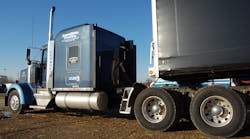The trucking industry often takes advantage of new drivers and thrusts them into an unsustainable employment cycle resulting in dissatisfied workers, massive turnover and chronic labor shortages, according to a forthcoming book. Truck driving, once a way to climb the nation's economic ladder, now has fallen short of that promise, says Stephen Viscelli, author of The Big Rig: Trucking and the Decline of the American Dream.
"The transformation of labor markets in trucking has disempowered workers to the point where it’s rigged in the favor of employers. Driving doesn't provide the kind of opportunities that people were expecting," he says. "People within the industry know all the pieces of the puzzle that I write about in the book. Nobody in the industry is going to be surprised that drivers are misled or that they misunderstand what’s happening to them or that companies offload economic risk to them."
Viscelli is an economic sociologist who focuses on labor markets and has studied the trucking industry more than ten years. He is a visiting assistant professor at Swarthmore College and Senior Associate of the Center on Wisconsin Strategy. He not only interviewed drivers, managers, shippers and others involved in the industry, but he worked and trained as an Over-The-Road driver for six months.
He says that the industry is unfair to drivers at every stage of their careers. "You can see evidence of it in every step of the labor process from the advertising of incomes that aren’t actually happening to the segments [like contracting] that people are being attracted to but don't turn out as expected."
It starts with training. "The industry now has systematically offloaded a large chunk of their training costs to the public and workers," says Viscelli. "Essentially you have anywhere from 150,000 to 200,000 workers when times are good circling into the industry and being burdened with debt for training… The cost of training contracts that many companies use also serves as a form of incentive for people to stay. Some would call it debt where you’re burdened with a $3,000 to $5,000 charge at 24 percent interest or whatever if you don’t work for the company for a year. Most of the workers I interviewed coming into the industry don’t understand that. They only see it on the back side. The more experienced drivers know this is happening [to the new drivers]. They talk about the 'CDL mill' and the 'professional steering wheel holder,' and it’s all very well known to folks who are in the industry. It’s just the people coming in who aren’t as aware."
At the next stage of a driver's career comes the realization that they're working without being paid. "There are tons of unpaid time sitting at docks and in traffic and the shifting of all these inefficiencies to new drivers. The inexperienced drivers that most big truckload companies are relying on don’t know any other way to do trucking so they don’t have a problem with pay-per-mile or sitting unpaid at docks - at first."
As a driver becomes more experienced, he or he realizes that this form of unpaid labor is unfair and they want to change their situation. "When drivers finally realize it - and it doesn’t take them very long - they want to get paid for that time, and they want control over their load assignments. That's when they look at independent contracting."
Viscelli spent most of his time looking at independent contracting, which, for many drivers would be "the American dream" of being your own boss, making as much money as your skills, time, experience and ambition allow.
Here again, he paints a less than rosy picture. "The industry has been able to completely redefine what it is to get people to work under what effectively becomes a forced-dispatch system and practice, according to the drivers I talk to. They work for the same pay rate regardless of the quality of the load. They don’t have control over the loads or the home time that they expected. The vast majority end up making less than they would as a company driver… Then, one, two, three years in, they see better opportunities open up for them in much better-paying private fleet niche markets. It has become a retention strategy by TL carriers to get people whose labor is worth more to stick around an extra six months, year, or whatever they can."
Viscelli says that he interviewed many drivers who were considering contracting, those who were in the midst of setting up their independent contracting business, and those who were currently contracting. "Basically, none of them got out of it what they expected. Even the most successful contractors said they would never do it again. The opportunity is just not there. The kind of picture that’s painted for you about what’s possible is just not accurate. For a lot of these guys, that’s how they describe it, and it wasn’t why they got into the industry. Ninety-eight percent of them don’t come in thinking 'I’m going to own my own trucking business.' Most of them are low-wage workers downsizing from a blue collar job or upscaling from a retail job; they’re not thinking about business ownership. Most of them are thinking about improving what is most likely an under $30,000 a year household income. The industry sells them on this dream [of independent ownership]; it does it through websites and promotions that create a kind of new American dream."
He notes that not all carriers engage in unfair behavior. "Of course, some companies treat their drivers with respect, pay them well, and their drivers enjoy their jobs."
Can this cycle be broken?
"I don’t know that I have a solution for it but the book looks at the way in which these kinds of transformations have happened. Go back to the teamsters. They solved a lot of these problems because they took wages out of competition; they ensured that there was low turnover. However, that's not a solution that the industry is going to be very interested in."
Viscelli says that the industry can change if it makes some bold moves. For example, they can get drivers home by forming regular lanes where drivers drop trailers and head back the other way, the way some LTL carriers do it. This would require a large investment in infrastructure either privately or publicly to build truck ports.
Would pay-by-the hour help alleviate solve many of the industry's driver issues?
"You’d have to have a bold company willing to do that first, because market forces make it difficult to change [the current model]," says Viscelli. "I have interviewed many company owners. I understand it’s a conservative industry and I don’t expect individuals to be able to overcome the market economic forces that have brought this about [pay-by-the-mile]. From deregulation on, it's been tough to be a trucking company and get the bottom line that you need to survive. I think the big companies have managed to do that now… It's potentially a time when some of the more profitable big truckload companies can start to change their model. I think some of them are interested in doing it."
But they probably won't, he says. "If we could get the top 100 companies with the lowest freight rates to pay their drivers by the hour, that would have an unbelievable impact. But I don’t think there's one company willing to take that risk. Drivers need to be paid more; they need a bigger cut of the revenue, but unless that translates into higher freight rates, it’s going to mean lower profits. Companies know that and that's why they’re not going to pay drivers by the hour."
The Big Rig: Trucking And The Decline of The American Dream will be published in April by University of California Press.





